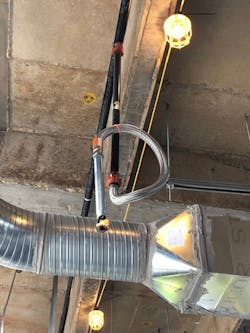The current global health crisis is placing enormous pressure on health care facilities and changing the way people think about safety. Conditions in health care facilities today make the performance of the building’s infrastructure more important than ever, magnifying the criticality of safety systems such as fire protection.
Prior to the COVID-19 pandemic, new ways of meeting updated NFPA guidelines had begun to offer better approaches to protecting people as well as advanced equipment from harm, and these initiatives will continue to improve the ability of hospitals, care centers and workers to protect their people, patients and property during challenging times.
With expectations changing, fire protection systems and construction methods are transforming to keep up, and new approaches to complying with NFPA guidelines are continuing to evolve.
Guidelines and Standards
Many of the challenges for fire protection in hospitals centers are around figuring out how to apply NFPA standards in the construction of new units and retrofitting existing facilities.
While most building codes define a health care facility as one where four or more occupants are not capable of self-preservation, the 2018 edition of NFPA 99 - Health Care Facilities Guide broadens the definition. Rather than specifying an occupant number, it defines “criteria for levels of health care services or systems based on risk to the patients, staff, or visitors.”
Protecting Technology
The guide not only expands the types of facilities that need to comply but also changes the focus from meeting prescriptive requirements to delivering performance-based compliance. The goal is to allow flexibility in designing fire safety systems to meet performance standards.
Rapid technology development in the health care space has brought about significant changes. Today, fire protection products used in these facilities must address bulk gas storage and security requirements as well as an increase in pharmaceutical products that require refrigerated storage. Additional hazards that increasingly are incorporated into health care facilities include robotic and imaging equipment, clean room research facilities, and data centers.
The introduction of on-site data centers and the need to safeguard them is a case in point. On-site data centers centralize IT operations and equipment vital to the continuity of daily operations and store critical data.
A fire protection system installed in an area that houses a data center needs to contain the fire, protect the equipment from damage and ensure minimal downtime and data loss. In fact, the need to protect the sensitive computers in data centers is one of the main drivers in the development of inert gas, water mist and hybrid fire extinguishing systems.
Victaulic Vortex™ is one such hybrid system. Based on cyclonic distribution of nitrogen and potable or de-ionized water, it has been proven to decrease risk of damage in sensitive areas. Because of the nature of distribution, there is nearly zero surface wetting, so there is little cleanup required.
Another interesting aspect of technology’s impact is the way it is changing fire protection system development. The introduction of 3D printing has expedited prototyping, which has significantly decreased the time required to introduce products to the market. This has resulted in 3D printing improving the efficiency and quality of healthcare fire protection systems faster than ever before.
BIM Coordination
The way construction projects are being planned and executed also is driven by advances in technology. Building Information Modeling (BIM) is now an integral part of the building process.
Large-scale projects – like additions or retrofits at health care facilities – rely on BIM to coordinate the details of the project from inception to completion so work can be carried out swiftly, efficiently, and with minimal disruption. The improved collaboration it offers enables challenges to be identified and resolved more quickly, which makes keeping to the schedule much easier. Incorporating prefabrication and modular strategies in BIM delivers further efficiencies by allowing field variables to be controlled and construction to be meticulously planned and executed.
Aesthetics
Interestingly, patient satisfaction within hospitals now is scrutinized to the same level as health outcomes, so improving the hospital’s atmosphere has become a priority. Fire protection systems must fit into the architecture, accommodating sophisticated ceiling and room designs in a way that does not disrupt the aesthetics. That means the components that make up the system need to be adaptable as well as functional.
This is one of the reasons the Victaulic VicFlex™ line of flexible solutions has grown rapidly in recent years. Flexible drop solutions solve for installation challenges like architectural ceilings, limited interstitial space, and temporary protection. Products include a flexible dry sprinkler and components that simplify installation in areas like data centers and parking garages, meeting or exceeding NFPA 13, the industry benchmark for design and installation of automatic fire sprinkler systems.
The Future
As expectations on the part of end users change and codes and standards from governing bodies evolve, manufacturers of fire protection systems will have to be adaptable to remain competitive.
Technology is shifting the demands placed on fire safety systems, and construction methods are continually improving. Regardless of future challenges, BIM will continue to improve the construction process, and versatile components within the fire safety systems will allow them to meet the demand for reliable protection.
Now in her 10th year with Victaulic, the author specializes in fire protection product development and has nine years of experience in fire suppression. She is a graduate of Tufts University, with a degree in civil engineering.













